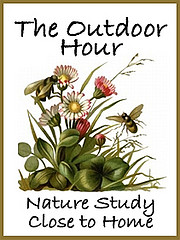 Hi, I'm Heidi and I homeschool my two sweet kids. I want them to know that learning is an exciting lifelong adventure! We love great books, unit studies, notebooking, lapbooking, and hands-on learning.
Hi, I'm Heidi and I homeschool my two sweet kids. I want them to know that learning is an exciting lifelong adventure! We love great books, unit studies, notebooking, lapbooking, and hands-on learning.Last Child in the Woods ~ Stepping Back
I’m continuing on in the book study on Last Child in the Woods by Richard Louv hosted by Nicole of Journey to Excellence. Be sure to click over and read her thoughts on Chapters 12, 13 and 14. We’re getting to the part of the book with ideas on reuniting your child with nature.
The main thought to hit me during Chapter 12 came when the author stated that we should strive to make the experience in nature as unorganized as possible while still meaningful. I am a list-making lesson-planning micro-manager, so I have to fight my personality here. The message came again in a quote from E.O. Wilson: “Hands-on experience at the critical time, not systematic knowledge, is what counts in the making of a naturalist.” Ouch. Then in two different posts Barb (from Harmony Art Mom) used these quotes from Charlotte Mason:
Children are quick. In fifteen minutes, they will have finished with their sight-seeing exercise or imaginary picture painting. Other than that, an occasional discovery that the mother shows them with a name and maybe a dozen words about it at just the right time are all that’s needed; the children will have formed an interest in something they can continue on their own. Just one or two of these discoveries should happen in any given day.” Charlotte Mason, volume 6 page 78
They must be left to themselves for a good part of the day to take in their own impressions of nature’s beauty. There’s nothing worse than children being deprived of every moment to wonder and dream within their own minds because teachers and adults are constantly talking at them, not leaving them a moment’s peace. Yet, the mother must not miss this opportunity of being outdoors to train the children to have seeing eyes, hearing ears and seeds of truth deposited into their minds to grow and blossom on their own in the secret chambers of their imaginations.” Charlotte Mason, volume 1 page 44
I adore nature study and it is a highlight of for all of us, but I need to beware of making every moment in nature an official study and thereby not giving my children a moment’s peace to enjoy and experience nature for themselves. I like the description: a dozen words at just the right time.
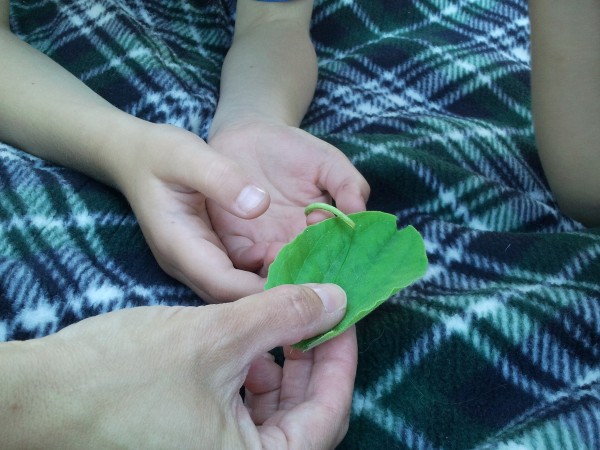
Chapter 13 reiterates the message: don’t make time in nature a chore or another “Fine Educational Opportunity” (love the terms!). There are many ideas in this chapter to connect your kids with nature, beginning with connecting yourself with nature and letting your enjoyment be contagious. Among the many ideas for great activities to do with your kids (the with is important) he talks about making walks a mutual adventure, not a forced march. Here I’m guilty again, at least at times. Believe it or not, I may have been better about some of this before I was homeschooling. When I wasn’t trying to teach them everything under the sun all the while having a way to show that they learned it I was a little (okay, a lot) more relaxed with our time. The good news for me: after reading this book we have been getting outside more already, and through homeschooling and nature study I’m reconnecting with nature. Nature study has rekindled my interest and excitement about the natural world. As I enjoy learning all I can, I need to remember my children’s ages and Charlotte Mason’s edict: just a dozen words to them, not unloading all the fascinating information I’ve read. I have a lot more work to do on my approach, but I am happy for the curiosity and excitement I see in my kids. As we sat at a lake this week my son kept bringing things to me that he thought were exciting (water lily flowers and seed pods, various dead insects) and he knew I’d be excited to see them, too.
Chapter 14, entitled “Scared Smart” dealt with parents’ fears about kids being out in nature. As I’ve mentioned, I am a worrier so this is a difficult area for me. The author suggests that time in nature can foster “hyperawareness,” accentuating their senses and teaching them to pay more attention to their surroundings while also increasing their self confidence, leading to kids who are safer all around. The worrier in me did feel better when he talked about having them be with friends and have cell phones when going beyond our eyesight. My kids are too young for cell phones, but I am trying to tweak things a bit. I’ve had the opportunity a couple times to use the method he calls controlled risk: giving some physical distance, so even though I keep them within eyesight they get a little more of a solitary feeling. That’s me in the photo below, they’re walking along the beach ahead of me. Baby steps, right?
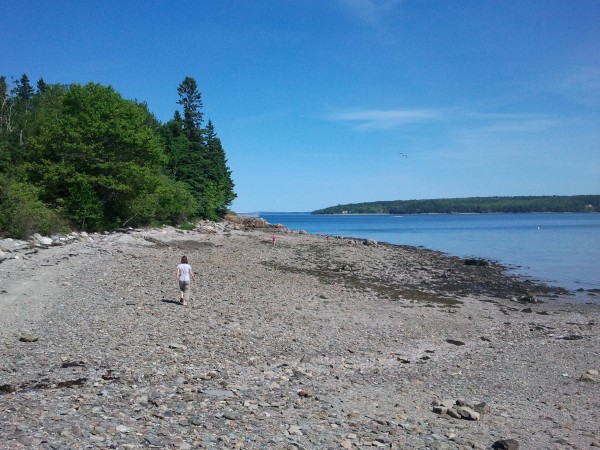
So my take-home message this week, in short, is to take a step back: don’t hover and don’t talk at them the whole time. Come back next week for Chapters 15, 16 and 17. The next chapters have more information on connecting your child with nature, both in daily life and in their education.
2012 ~ Summer Curriculum and Plans
I hadn’t planned it ahead of time, but we ended up having a relaxed school month for June. We did fun read alouds (Matilda by Roald Dahl had us in stitches), began new journals, and kept going with nature study, but most other schoolwork took a back seat. We camped (twice), had a three-week visit from my brother-in-law who lives abroad, worked in the garden, and enjoyed many summer activities. I knew after our more rigid schedule for April and May that we would all be ready to take some time off, but I didn’t think it would be a month before I’d have my summer plans ironed out, my lists made (for myself and the kids) and be ready to dive in.
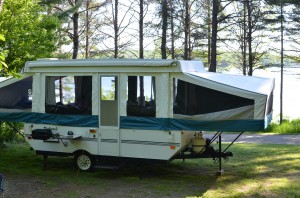
The good news? It’s July, I am ready with my plans, and it felt good to get back into a routine. My daughter cheered when I said we’d be making a minibook today, and my son ran to dress up as a pirate when I said it would be about the Barbary Pirates. That’s a good reaction for our first day back in the saddle!
Though we homeschool year-round, summer is a time we enjoy a more relaxed schedule, fitting in schoolwork around the weather and fun times camping and boating and playing with friends. Last summer we averaged about two days of school per week, broken up in chunks of a couple hours here and there. Most of what I have planned for this summer are things we’ll study together (a favorite in our house). I do have a bit of individual work for each of them just to prevent any “summer slide” in areas where that is a concern. Here’s the plan:
Big Sister’s Fourth Grade Individual Work:
- Math: She will log in to Khan Academy twice a week to work on new material and any topics that come up for review. I love how Khan automatically puts topics up for review, and has the student answer questions correctly to take it off the list! I also will have her work on Xtramath (you can read my post about Xtramath here) three times a week. We’ll keep plugging away at these math facts until they’re solid as a rock in her brain.
- Piano: No break from piano lessons (not that she would want one) so she will continue to practice 30 minutes each day.
Little Brother’s First Grade Individual Work:
- Funnix: He is making good progress as a beginning reader using the Funnix reading program so we will continue throughout the summer. My goal is 2-3 lessons a week.
- Math: Playing store and other math games to practice telling time and addition and subtraction.
Together Studies:
- History: We spent last summer studying the Revolutionary War, then backtracked a bit and studied the early explorers and Pilgrims in the fall. After that we would touch on history topics as they came up during our study of the fifty states, but history was not the focus as much as geography and modern life. I was anxious to focus on history again and though I knew the time period I wanted (post-Revolutionary War & Westward Expansion) I was unsure how to go about it. I decided on a Time Travelers unit from Homeschool in the Woods on the early 19th Century. My initial plan was to use this study just through the summer. Now that I’ve had a chance to go through it, I see there are so many wonderful topics and activities that I don’t want to rush through. I plan to add in Charlotte Mason-style living books when possible. Since it isn’t the only thing we’ll be working on I believe we’ll continue with this well into the fall. I’ll post a more thorough review of the Time Travelers unit when we’ve had a chance to work with it.
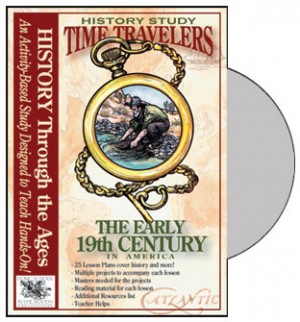
- Science: Nature Study has become an integral part of our homeschool, and a key piece of my children’s science education. We have thoroughly enjoyed and will continue using the ideas from Barb’s Handbook of Nature Study blog and her Outdoor Hour Challenges. As I mentioned in my review of our last school year, I wanted to spend even more time on science. My son has been begging me to learn about the human body, so I worked on putting together a unit study. As summer neared, our homeschool group’s science teacher quit, and I formalized my desire to cover more science basics, I decided I wanted to try an official science curriculum. I requested and received a free copy of Real Science Odyssey’s Life Level One program: the age range is perfect, it’s hands-on, and it includes a study of the human body. I’ll be posting a full review as we work with it. It is a year-long program so it should work well to start now and continue throughout the school year, especially since I plan to slow down as we hit the human body topic and use some of the other resources I’d already put together for a unit study.
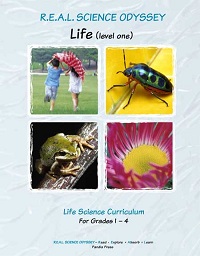
- Journals: I’d seen a great idea for a journal jar and wanted to use a similar plan. Last summer the kids wrote in journals often, but during the busier school year regular journal writing fell by the wayside. I think summer is a great time to jump back in. I didn’t print the journal prompts provided in that link, but looked through the prompts and picked the ones I liked, added a few of my own, then typed up a list of prompts and put them in a jar. They are all questions about them: likes/dislikes, special memories, plans for the future, what would you do with one million dollars, that kind of thing. I hope with the journal jar it will not only be fun, but a great keepsake for years to come.

- Reading Aloud: This one is sort of a given for homeschoolers, right? In fact, we’ve enjoyed reading aloud since my oldest was a baby. But two things have placed reading aloud in the forefront for me. I’ll be doing a post on this later and let you know what two resources moved this from a filler spot to a do-first-even-if-you-don’t-get-anything-else-done spot. First on our reading list is going to be the Little House series since it’s a great go-along for our history studies. I still read picture books frequently: some nonfiction science and history books, but many just because they’re fun.
Last Child in the Woods ~ Barriers to Free Play in Nature
I’m chiming in again in Nicole’s book study on Last Child in the Woods from Richard Louv. Be sure to visit her post to read her thoughts and those of others participating in this book study. This post covers chapters 9-11, which are in the section of the book dealing with why kids don’t play outside.
Chapter 9 had me nodding my head all over again with its discussion of over-scheduled kids. This topic had already come to my mind while reading this book, as I mentioned in my post on chapters 5-8. Not only is there less time for recess during school, but homework, lessons and other organized activities take up much of the time left after school. Like I said, I’m happy for the chance to homeschool. I can prioritize my child’s time to allow for the things that are important. Nicole mentioned the suggestion on page 121 in her post, and that was just what I needed, too: take time in nature out of the leisure column and put it in the health column. I love to make lists and check things off, and often have a hard time relaxing and not feeling like I’m accomplishing something. After reading all the chapters on the benefits to time in nature, I am hopeful I can view unstructured time outside as just as necessary for the kids as working on math and not let it fall by the wayside if we’re busy.
Chapter 10 is a little harder for me. I agree with much of it. I know the chances are very low that someone will abduct my child as they ride their bike down the street. But I am a worrier and don’t see myself being able to relax a lot in this department. As I discussed in my last post I hope to add more natural elements to our yard, along with giving my kids more time outside without me orchestrating activities. I can’t see myself letting them roam the neighborhood out of our yard, or head into the woods without me, but I can try to take them there more myself and maybe hang back a bit. Baby steps, right?
Chapter 11 was an interesting one. I had mentioned in my first post of this book study that I’d been incorporating nature study quite a bit, and hoped to do so even more. This chapter really cemented that plan for me. The discussion of how abstract many children’s nature education is rang true with me: in school it’s “Go Green!” and recycle, and learning about rainforest destruction or endangered animals, but “nature” is still a concept they are just seeing in a book or show. They aren’t out in it experiencing it and falling in love with it. This is how you really improve environmental issues, not by teaching them about things far away that they can’t see, touch and smell for themselves. I liked the quote from biologist Elaine Brooks on p. 141: “Humans seldom value what they cannot name.” So if kids can identify Pokemon characters better than native plants, what do you think they value the most? I wanted to incorporate more science education in our homeschool, and I realized after reading this chapter that the nature study that we already enjoy can be a big piece of their science education, not something separate that I fit in only if we have time. I just have to mention Barb at the Handbook of Nature Study blog while I’m on this topic because ideas from her blog are the how of nature study for us.
I’m really enjoying this book. Now that I’ve been persuaded of the importance of time in nature I am excited to delve into the parts of the book with ideas for implementation of a nature-child reunion!
Nature Study ~ Exploring the Beach
We had tremendous opportunities for nature study while camping at our favorite spot on the Maine coast this week. Learning while camping…that’s what I love about homeschooling!
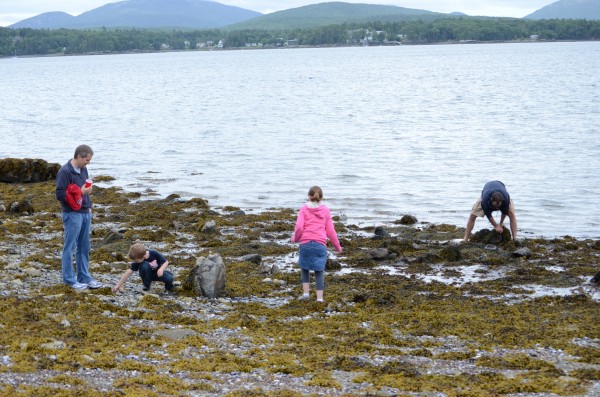
A beloved uncle was along for the trip and dazzled the kids with his ability to find creatures to observe. Even my usually squeamish daughter was holding and touching everything. I stood by with my camera attempting to capture all the amazing creatures and the wonder the kids had holding and touching them. We had done a Homeschool Share unit study on oceans last year and learned about some of these same creatures, but there is nothing like a hands-on experience! Barb talked in her newsletter about children being able to remember their experiences at the ocean beach years later, and I am confident this morning of exploring with all their senses will stick with them for a long time.
There were lots of crabs. It was interesting to feel the differences in their shells–some were quite soft from molting recently.
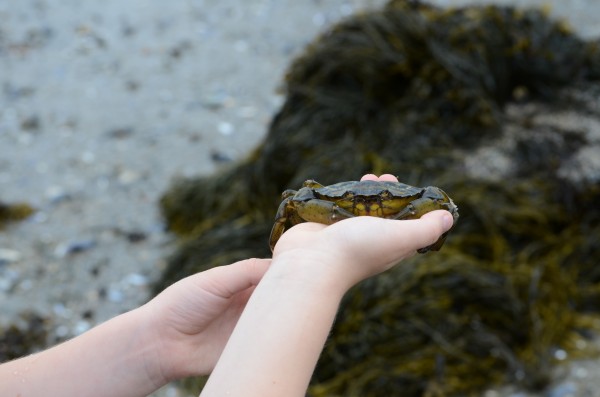
They found many different sizes.
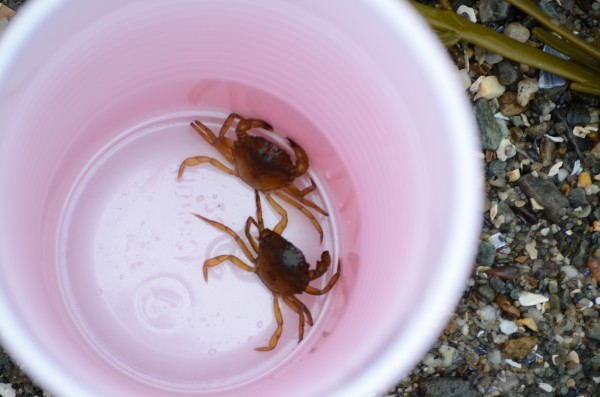
The sea stars may have been my favorite. Seeing their tube feet move around up close was amazing.
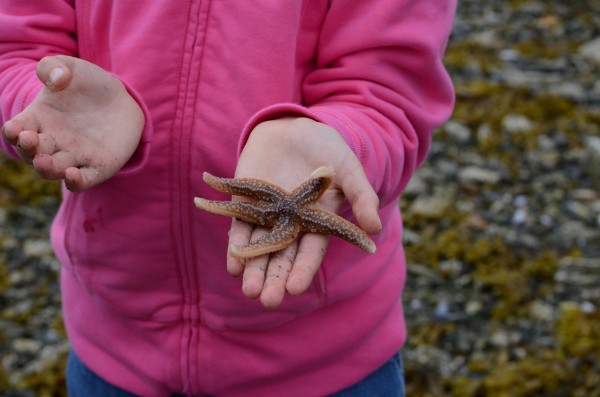
This was really exciting: a sea star missing a ray. I was able to remind the kids about their ability to regenerate that we learned about last year.
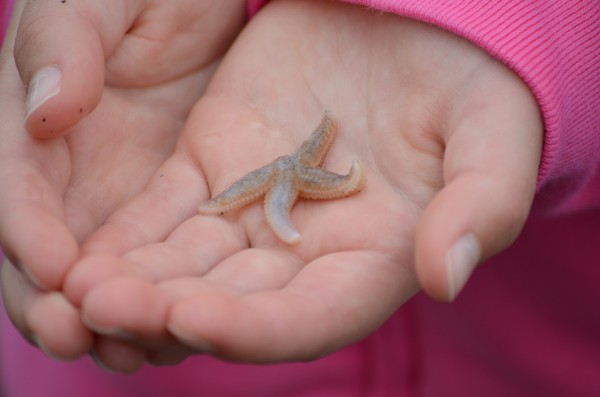
For the record, I did NOT hold this guy. Eels would be a good subject for future study because we didn’t know much about him.
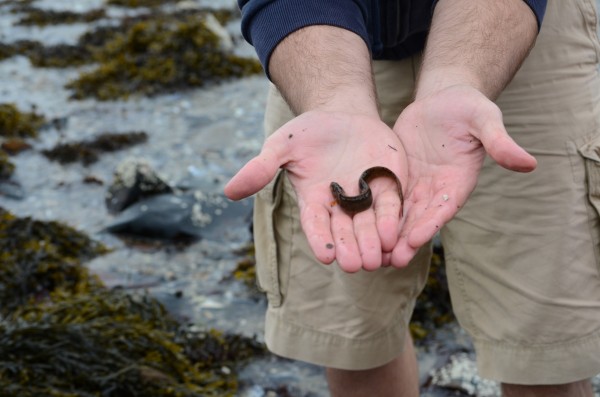
While Daddy grilled lunch back at the camper the kids worked on their journal pages using a free page included in Barb’s Handbook of Nature Study June Newsletter.
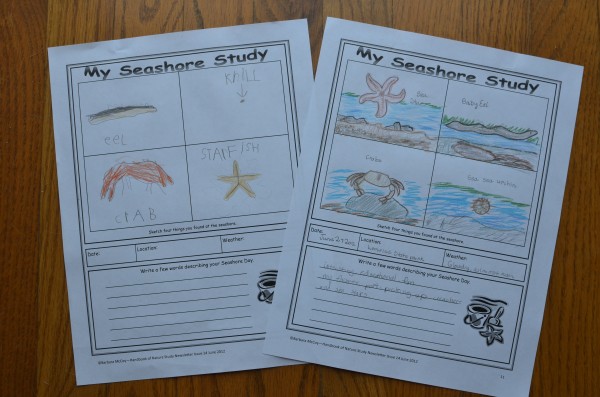
Using ideas from Barb’s Outdoor Hour Challenge: Sand and Soil we brought home some sand to study. I took a sample from higher up the beach and then, at my daughter’s suggestion, another sample very close to the low tide mark. We spread some of each sample out and enjoyed inspecting them on white and black paper using a magnifying glass.
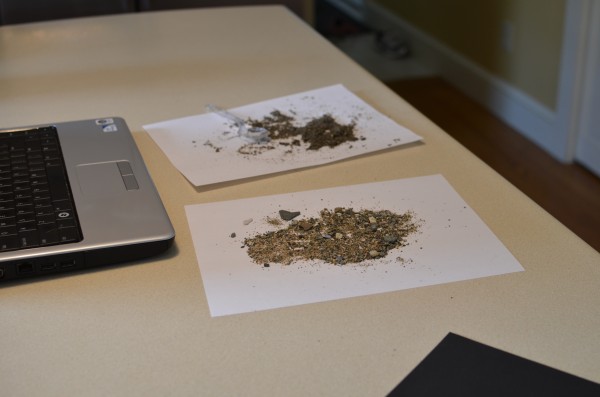
They were impressed when we looked at a piece of quartz under a little hand-held microscope.
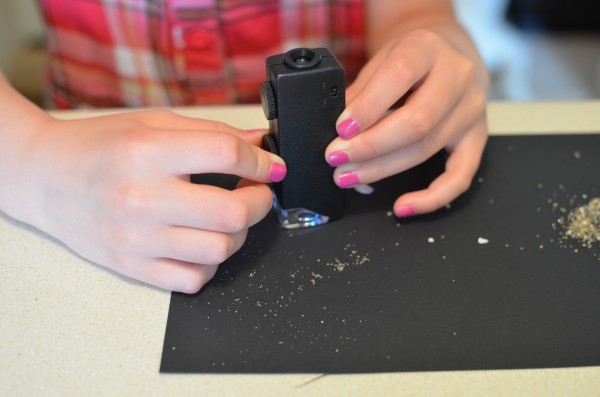
My son was completely amazed that some rocks were attracted to his magnet! He spent time when we were done just moving the magnet around over the sand and making rocks move.
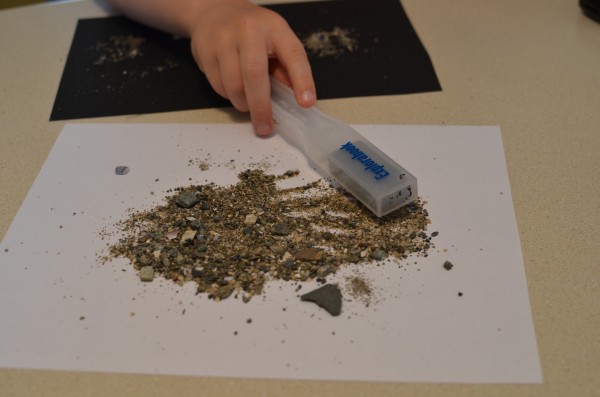
I grabbed some soil from our garden and we performed the soil experiment from Barb’s links. I didn’t get too technical with the kids, but we did talk about how quickly the sand settled, the sizes of particles in the different layers, and as a gardener I talked a bit about the difference soil types can make when you’re planting. I was intrigued by the idea Barb showed of keeping sand samples from different beaches you visit, so this will be our sample #1!
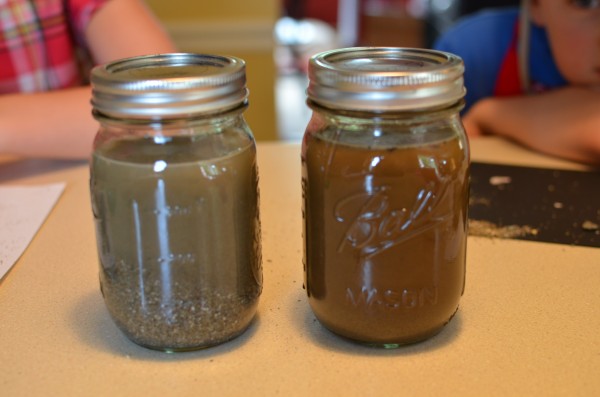
What a terrific week: camping at our favorite spot, time spent with a crazy-fun uncle, and a lot of nature study thrown into the mix. I love summer school!
Last Child in the Woods ~ The NEED for Nature
I’m back with more thoughts on Last Child in the Woods by Richard Louv. Nicole from Journey to Excellence is hosting an informal book study, and you can read her thoughts on Chapter 5, 6, and 7 and Chapter 8. Be sure to head over to her blog to read her thoughts and those of others participating in this interesting book discussion. I was a little behind so I’m here to share my thoughts on Chapters 5-8, which are all in a section of the book explaining why we need nature.
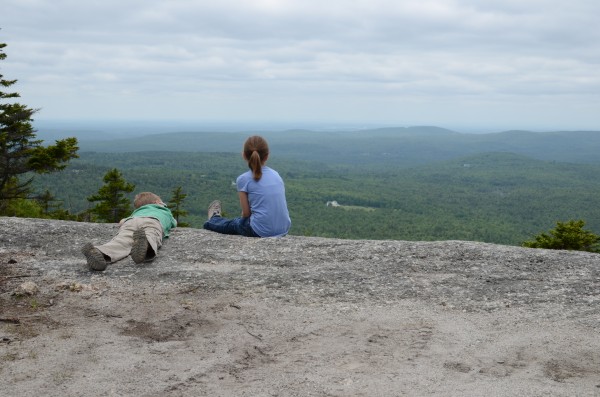
I’d commented at the end of my thoughts on Chapters 1-4 that I thought reading this book would make time in nature move higher up my priority list–and this section of the book has definitely done that! Chapter 5 discussed how nature develops the senses. I was especially intrigued by his thoughts on “primary experience” and how most of what children get these days is dual-sensory information from television and computers, with fewer direct experiences doing and building with all their senses. The section on “packaged nature” reminded me of the difference in listening to a thunderstorm CD versus watching the flashes of lightning and feeling the power of an actual thunderstorm outside your window. I agree with Nicole’s feelings of videos online being far less engaging for my children than a hands-on experience. We had read loads of books and watched shows about the Pilgrims, but nothing cemented it for my kids like our trip to Plimouth Plantation to be immersed with all our senses in what life was like for the Pilgrims.
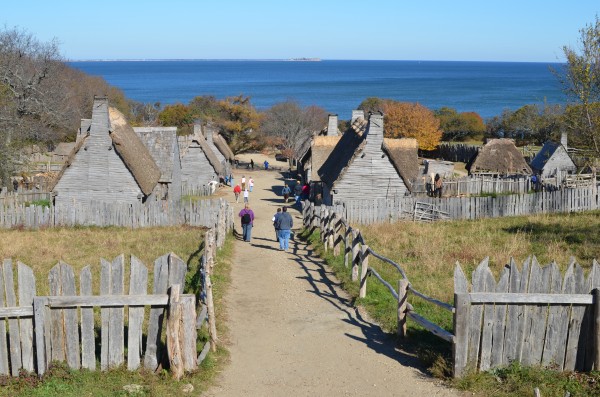
Chapter 6 delved into the theory of multiple intelligences developed by Howard Gardner, and the relatively recent addition of an 8th intelligence termed “nature smart.” I love the description on page 78: “Perhaps the eighth intelligence is the intelligence within nature, the lessons waiting to be delivered if anyone shows up.” The discussion with a landscape architect talking about designing more natural outdoor spaces had me really brainstorming ideas for my yard. What can I incorporate in my small suburban yard to make it more wild and natural, and thus more stimulating to the senses and imagination?
Chapter 7 talked about “loose-parts” toys that are open-ended, allowing children to use them in multiple ways. This is one of the sections in the book where I found myself generalizing and applying the ideas to not just time in nature, but childhood in general. I have often bemoaned the trend in children’s toys having a single way to play with them. It’s why I’ve always leaned towards things like building blocks and dolls that require imagination and creativity. Coming back to nature, I want to incorporate more “loose parts” for outdoor play and make sure as I garden and landscape around our small yard I am thinking of stimulating my children’s outdoor play.
Nicole was right when she said Chapter 8 was a meaty chapter, and I found myself taking copious notes. Even in the early grades I was struck by how little recess my daughter had at school, and I know it is even worse in other areas. (I had to laugh at the quote: “Lifers at Leavenworth get more time in the exercise yard.”) What I think makes it especially hard for children these days is that when they get home they have homework at a far younger age, and then if you try to add enrichment like music lessons they have even less free time and exercise. I am thankful for the ability to homeschool…if my children were in public school it would be harder to dramatically increase their contact with nature. The reiteration of time in nature as restorative, allowing you to come back with better ability to focus, really hits home for me. My son is a very active boy, and even in preschool the teachers raised questions about his ability to pay attention. Like Nicole mentioned with her son, I am confident he doesn’t have ADHD because he can focus for long periods of time if something is interesting to him. I do notice his attention waning sometimes at home, and up until now I would try to push through and finish our schoolwork so he could then have his free time. My new plan after reading this is going to be to take a break to head outside, and finish the schoolwork with better focus after we’re all refreshed.
There were two other things I took away from chapter 8. One, like Nicole mentioned, was about where we do our schoolwork. The study on the benefits of even a view of nature on focus and concentration was interesting. In a happy coincidence I recently rearranged our schoolroom so both kids have a better view out the windows, but I am going to focus more on what they see out the window. I’m thinking of adding another bird feeder there, or maybe a birdbath. Another piece of information from this chapter requires a little rearranging for me. A work-in-progress study seems to show that a walk in a natural setting is more beneficial than a walk in a manicured residential area. As I said in my earlier post, we get outside nearly every day but usually for a walk around our neighborhood. I am going to make it a goal to head to more natural areas for our walks more often. Like Nicole says, as parents we just need to make the effort.
2011-2012 School Year Review…From My Kids
After all the reflecting I’d done on our homeschool year, I thought it might be interesting to get the perspective of my students, too! I remembered a post I had read last spring about getting input from your kids on Heart of the Matter. Jimmie’s advice was to ask your children questions as you evaluate your homeschool. Armed with her questions I conducted a little interview with each of my children (separately so they wouldn’t be influenced by each other). Some of the answers I completely expected, a few surprised me, and one just made me laugh.
I know math is not my daughter’s favorite subject, so I expected it to top the list on any question about what she doesn’t like. Based on the sheer amount of times she mentioned math negatively I know I have my work cut out for me. I am determined to help her see more of the value in math, and I’m hoping the book my husband and I are both reading, What’s Math Got To Do With It by Jo Boaler, will help.
Both kids listed read aloud time as their favorite part of the day, and their favorite subjects were things we do together. I wasn’t surprised by those answers, but it did reinforce for me what is already in my plan: working together on subjects whenever possible and more reading aloud. Both kids talked about wanting to spend more time studying history, which I’m excited to do as well! It is one of the subjects I am learning right alongside them.
Surprising answers included my daughter’s goal of better grammar (I’m glad I have exciting plans for that for next year), my son’s goal of learning to cook and speak a foreign language (I wouldn’t have guessed those two goals at all–and I definitely want to work on them with him). It was great to get them involved with goal planning and find out what was important to them.
The answer that made me laugh: whenever I asked my son about something he didn’t like, he asked that I “just draw a smile” because he couldn’t think of anything he didn’t like!
While our family was on a long car ride I took the time to discuss the answers with the kids and their dad. We enjoyed a nice, open discussion with everyone together. I think the biggest benefit from this exercise was showing the kids that their thoughts are important. They’re young now, but I hope we’re laying a good foundation we can build upon as they get older and take more of a role in directing their own education.
2011-2012 School Year Review
There were times this year when I felt like I’d rearranged things too often…but I tried to remind myself that the beauty of homeschooling was the rearranging: if something isn’t working I can adjust until it works! While camping on the coast of Maine just after we finished full-time school I took the time to really reflect on the year and what my plans were moving forward. Luckily, in spite of all the changes and adjustments and trying to figure things out, one over-riding truth remained: homeschooling is a great fit for our family.
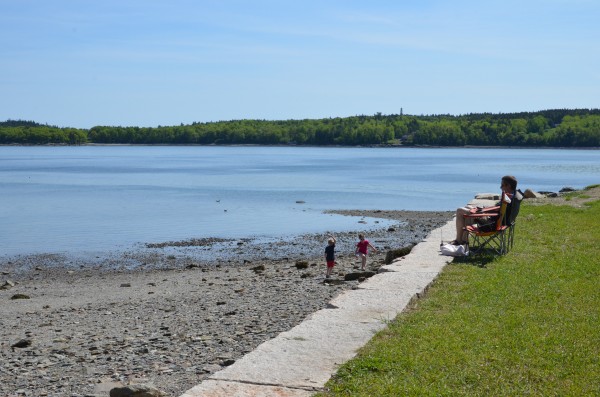
What did work this year:
- All About Spelling: My daughter and I both enjoyed this spelling program and look forward to moving ahead with it next year. The biggest bonus: I can see using it with my son when he’s ready, too. Since my children have such different learning styles, if a curriculum can be used with both of them it offers something for everyone!
- Funnix as a reading program for our son. We are so thrilled with his progress in reading and will continue through all the lessons.
- 50 States Study: This year-long study I put together from various resources was the highlight of our year. My son was actually sad when we finished the last state! We had so much fun learning about our country and its geography, history, and people.
- Nature Study: I may say this too often, but finding Barb’s site The Handbook of Nature Study blog was a God-send. I used her ideas on a regular basis and it’s a very welcome part of our school schedule.
- Working together on subjects: I will continue to combine subjects whenever possible. Both my kids are happier and still learn a lot when working together. It really becomes a bigger part of our life when we are studying the same topics.
- Homeschool book club: A friend arranged this casual group of a few homeschooling families meeting once a month, with each mom taking a turn planning the meeting. Getting together routinely with other homeschoolers was paramount to our success this year.
What did not work at all:
- Writing With Ease: At first we loved it. Then we dreaded it. Why? It felt like the same thing every day. A different piece of literature but doing the exact same thing. Once my daughter got the idea of summarizing the piece in two to three sentences I felt like it was too repetitive. So in December I dropped it, and it became the first purchased curriculum that I gave up on. At first it was disappointing, but then I felt empowered.
- Easy Grammar: This seemed okay at first, but then both my daughter and I learned something about ourselves: we are not worksheet people. This especially surprised my daughter who, coming from public school, had been overjoyed to see workbooks arriving in the mail when I began ordering homeschool supplies. I felt like it was too shallow and mixed up and that the actual teaching of grammar was missing. Plus it wasn’t carrying over into her work, so I dropped that after December. The rest of the year we focused on grammar in her own writing, making index cards with grammar rules. That worked well to some extent…but I still see room for improvement in self-editing. Stay tuned for next year’s plan, because I’m excited!
- Math Workbooks #1: Okay, so maybe we both needed to let go of our attachments to workbooks. I started both kids on Singapore Math. It took a fair amount of prep and teaching time for me, and none of us was enjoying ourselves. Mr. Technology (my husband) had been trying to show us Khan Academy and my daughter and I resisted. When we finally tried it we both loved it. I don’t see a lot of people using it as their curriculum but it works for us. I’m keeping track of the core curriculum standards and standards in our local school district so I can be sure she covers necessary topics, and I try to bring math into real life to solidify what she’s studying. Did I mention it’s also free?
- Math Workbooks #2: For little brother we did finish the Singapore Earlybird Kindergarten Book A. The problem: math concepts on paper don’t work for him. I figured that out early but thought the workbook would help keep me on track with which concepts to cover. It just wasn’t time or money well spent, though. We found computer games and apps and hands-on activities like playing store to be the best way to teach math concepts to him. Bonus: free and he is excited about playing with numbers.
What needed some tweaking:
- Science: Our weekly science class was wonderful and was where we met other homeschooling families. Unfortunately our instructor decided he had too much on his plate and he cut our class. I had already been considering supplementing at home for two reasons: science is little brother’s favorite subject, and although the class and teacher were fun and exciting, I thought my kids could use some building blocks of science that weren’t being covered. So stay tuned for next year’s plan, because I’m excited about this, too!
- My scheduling: I started off the year just a bit too uptight. I was nervous and had a schedule typed out down to every fifteen minutes. I kid you not, I had a spreadsheet that showed who was working on what, with a little “M” showing which child I was helping. Honestly, what was I thinking? That left no room for Daddy suggesting we go out for breakfast, the dog throwing up on the carpet, or wanting to play oustide after lunch because it just snowed and it’s that really good sticky snow! Not to mention if a certain subject took a little longer and the other child needed me or didn’t know what to do next. My little schedule went through several redesigns over this first school year, and I finally landed on what works for now: a simple weekly grid with nice big open boxes for each day, plus list boxes for weekly goals. I can write in something happening on a certain day (like a class or piano lesson) and then I just work away at our weekly goals in a flexible way. Maybe today the weather is nice and we’ll do some nature study. Or we feel like flopping down in the living room to finish that book. Or the kids feel like cut-and-paste crafty lapbook work. I based my schedule on this free weekly planner printable I found at The Home School Mom. I just broke up the “To Do” box on the right into three boxes: one box for together work and one for each child’s individual work.
- Tracking school days: I kept meticulous records, but didn’t have benchmarks to guide me throughout the year. I had set a self-imposed goal of finishing our required 175 days before Memorial Day and was determined to meet it. We had to work really hard in April and May to finish on time. It was worth it when we were camping the next week and knew one year was behind us, but I plan to be more prepared next year.
We’re now well into our more laid-back summer school schedule and enjoying ourselves immensely. I’ll post our summer homeschool plans as soon as I get a chance!
Changing My Mind About Report Cards
I had no plans to give my children a report card. I don’t give tests or come up with grades, and besides, I’m the mom and teacher, so who is a report card really for? Isn’t it to tell the parents how their child is doing? Then I was reading on Harmony Art Mom (by the same Barb I’m always mentioning from the Handbook of Nature Study blog–she’s just overflowing with ideas I love) and she referred to a post on narrative report cards. I had to click on the post link and read it, and was immediately persuaded that it was a great idea. My favorite part was how Barb included information about topics other than the basic school subjects in her report card: things like field trips and volunteer work.
Barb has a great sample narrative report card at the bottom of her post, and I followed much of her format with a few variations. For one thing, I don’t have a cool school name or logo–maybe I need one! Secondly, like I said, I don’t give grades and we certainly don’t have credits. I also only intend to do one report card per year. I listed the subject areas very generally: Language Arts, Math, Science, Social Studies, Music, Art, Health/P.E., and then had a space for a narrative in each area. On each of the subject areas I would list how we covered the topics, including curriculum used, any curriculum changes and why, what we accomplished, and goals as we go forward. I also could add in if there is a lot of good effort, or if the attitude could use a little improvement. Then I listed other areas: field trips, literature lapbooks, unit studies, volunteer work, and personal development. Personal development was a fun one that allowed me the freedom to discuss their passions. For example, my daughter sewed a lot this year and really advanced her skills. She took classes, sewed with me, and also attempted (and completed) projects on her own. I appreciated being able to include that kind of information.
It did take a bit of time for me to put together, but it became a wonderful summary of our year: a journal of learning and activities, things accomplished and also things to work on in the future. Reading it over I was proud of all we had done, and I know my children and I will enjoy looking back in years to come.
Last Child in the Woods ~ Free Play and Fear
I had requested the book Last Child in the Woods by Richard Louv from interlibrary loan, and then I saw that Nicole from Journey to Excellence was going to host a book study. How perfect! Today I’ll be sharing my thoughts while reading the first four chapters. Be sure to click over and visit Nicole to read her comments.
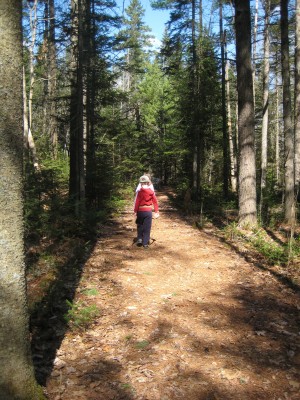
While reading the beginning of the book I was flooded with my childhood memories growing up in a very rural area on old potato farmland. In warm weather I was running around exploring in the woods, rolling down grassy hills, and visiting the frog pond. In winter I was sledding and building forts until my hands were blue. I remember very little of toys I had, but I can replay the sights and smells of the fields and woods in my mind.
After reminiscing my thoughts turned to the way my children are experiencing nature, and I am struck with a difference between my experiences and those of my children. I agree wholeheartedly with much of the author’s discussion of these generational differences, and how much less children are experiencing nature directly now. We are fortunate not to struggle as much with some of the impediments: homeschooling does give us more unstructured time, and we live in Maine with lots of access to natural areas. In Chapter 3 when the author quoted a British study that kids could identify Pokemon characters better than native plant species I gave myself a little pat on the back for incorporating nature study into our homeschool fairly regularly over the last year, and determined to work it in even more in the coming years.
After the pat on the back I felt not so proud in one area: free play in nature. With homeschooling I looked forward to giving my children more time to enjoy time outside, but truthfully free play has not happened as much as I would like. We do walk or ride bikes most days (thanks to our dog), but free play in nature is not as big a part of their lives as it should be. Often I’m with them and tend to be still directing things. I was especially interested the discussions in Chapter 4 on the type of outside environment, and how there does seem to be a difference between outdoor play on a structured playground versus a more unstructured natural setting. This is one area that is difficult because we live on a small lot in a relatively new subdivision with mostly lawns and gardens and no wooded areas. I’m afraid there isn’t as much nature to fuel the imagination in our backyard as there is in a less manicured area. I have to take them to more natural places, and when I do our time is limited by me wanting to get back home to my lengthy to-do list. I don’t want my responsibilities as an adult to shorten their time to be kids and experience the same play time I had as a child, but it really is difficult.
Other than my feeling the need to be home to get things done, the other barriers to unstructured time in nature for my children is my fear. I have a hard time if they’re playing where I can’t see them. I fear they’ll get hurt and I won’t be there to either prevent it or help when it happens. Add to that a fear I am especially struggling with this summer: ticks. I have had ticks on me recently, and I have a friend recently diagnosed with Lyme disease. I hate to douse ourselves with chemicals in order to spend a little time in the woods, but reading the many benefits in this book may push me to try getting out in the woods more, even if a hefty dose of DEET has to go with us.
As I read Chapter 4 about nature’s healing properties, I remembered during my teen years taking walks in an old farm field across the road. Once I walked out into it and over the hill, I couldn’t see a single house. It was just me and the wind and the wildflowers. It was so calming and a great time to think. I have seen days in our homeschool that just are not going well and time outside (especially in the woods) has saved the day. I am determined to use nature more to benefit both myself and my children.
I’m very excited to continue reading this book. It reminds me a bit of my feelings when reading The Read-Aloud Handbook by Jim Trelease. I already read a lot to my children, but that book reinforced for me the many benefits of it and assures that time for read-aloud will not be the first thing we cut if we’re low on time. I have a feeling time in nature will also be higher on my priority scale after finishing this book.
Nature Study–No Planning Needed!
Nature study is one of my favorite parts of the Charlotte Mason philosophy. We try to incorporate it as much as we can, with many of my ideas coming from Barb at the Handbook of Nature Study blog. One of the most common ways we fit in nature study, however, takes no pre-planning at all. You could call it interest-led or on-demand or lucky coincidence…
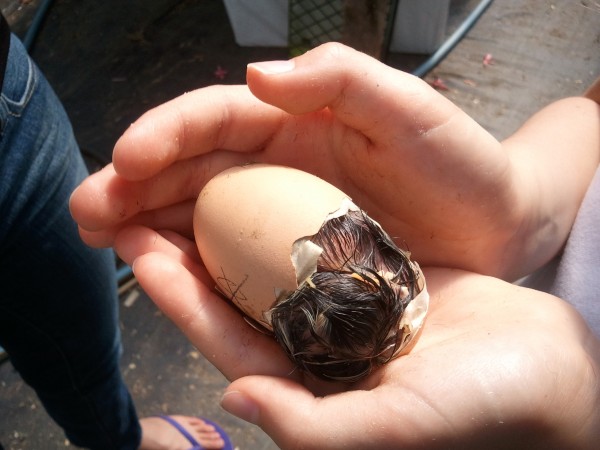
When we see something in nature that we’re curious about we spend time researching it. I know, amazing thought, right? And it really is that simple. The more complicated side is putting aside my plan or list and being willing to detour and slow down. It means when we are at our small town’s garden store for what is supposed to be a twenty minute shopping trip being willing to stay an hour and a half so my daughter could hold a chicken egg in her hand while it hatched. It means dropping the load of laundry to run to the window and see the bird at the feeder. It means crouching down on our neighborhood street (when I’m really just trying to get our dog some exercise) to watch a snail. It means stopping the lawnmower, grabbing the bug box and finding a way to get a huge green beetle inside it. (And yes, I did let out a squeal when he touched me.)
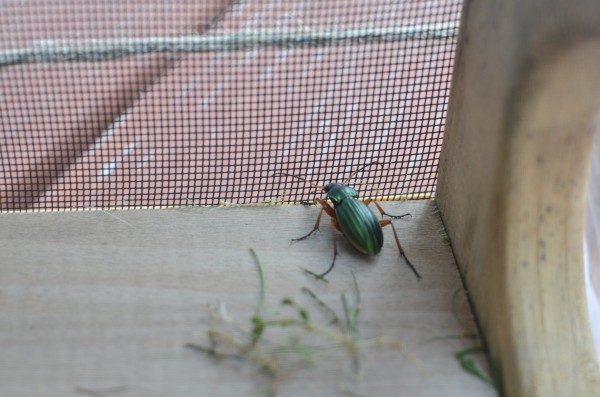
There is a great benefit to this method even aside from the easiness of it. Not only do we learn a lot about the natural world without tons of planning on my part, but it fosters my children’s curiosity. It has encouraged them to call out to me: “Hey Mom! Look at this! What is it?” I always try to go and see it. If we can we bring it home to study (like the garden snails I carried in a dog waste bag), otherwise we take a picture (great use for the camera on my phone).
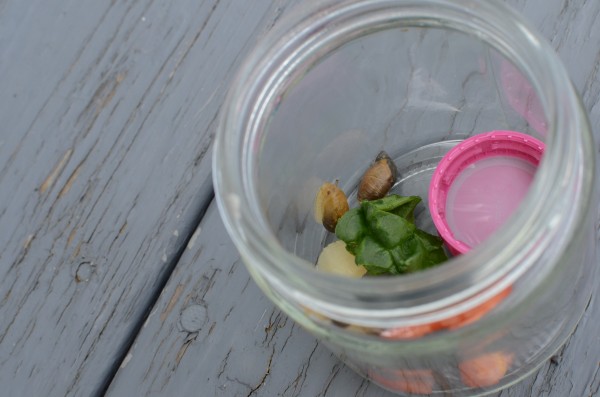
At home we follow through and find out what we can about our topic. I love having field guides and reference books on trees, insects, and birds around the house so we can grab those and start thumbing through to track down our item of interest. (As a side note: building a reference library doesn’t have to be expensive: most of our books I’ve picked up on clearance or at used book sales.) This can help with beginning identification on things like the big green beetle where I don’t know what to type in for an internet search. If we’re not positive of the identification based on the drawing or picture in our field guide, I’ll often do a Google Images search and compare the images with what we found to help us be sure. For birds you can’t beat Cornell’s All About Birds website to identify and then learn everything you wanted to know, and even watch a video or listen to audio recordings. If it’s just a feather you find, then check out the Feather Atlas from the U.S. Fish and Wildlife service. The Discover Life site has ID nature guides that cover just about every living thing. This site is so detailed it can be a little harder to navigate, but many of the guides have photos to make it easier. For instance, under insects you can choose caterpillars, then using the photos select the main body color, pattern, and other features to arrive at an identification.
That would be how I identified the caterpillar that gave my son an awful rash. Oh, and that was after my husband said, “I thought you weren’t supposed to touch hairy caterpillars.” I waived away his concerns, saying surely in rural northern Maine where I grew up we touched all sorts of them. I let the kids play with them for a couple hours, draw them and build them houses. Let me just say that I was really eating my words at 2:00 AM when my son was itching and crying covered in hives. My dear husband didn’t even say “I told you so,” though I really deserved it!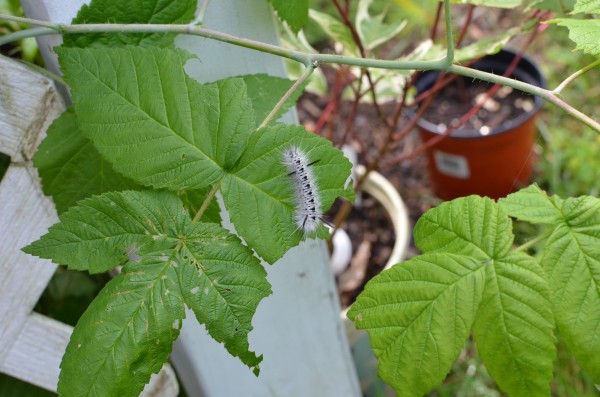
My favorite nature reference book that we own is The Handbook of Nature Study by Anna Botsford Comstock, an amazing book originally written in 1911. It doesn’t have color photos like most field guides, but it’s loaded with interesting information. That’s where we pick up fascinating in-depth knowledge, like how the bleeding heart flower has a hinge to expose the pollen while bees are drinking the nectar. Barb’s Handbook of Nature Study site is a great place to find educational links and study activities if you want to dig deeper. It was through links on her site that we learned a garden snail can have over 400 babies in a year (and why the garden snails we brought home were returned to their previous area!) And if it’s something my kids are still showing a lot of interest in, we’ll grab books on it at the library and read until their curiosity is satisfied.
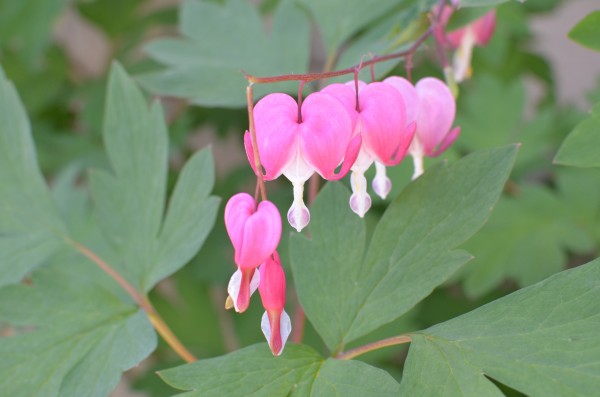
At least until the next time I hear: “Hey Mom! You’ve gotta come see this!”
